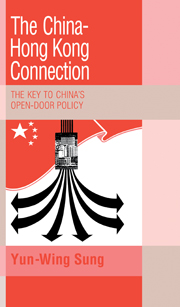Book contents
- Frontmatter
- Contents
- List of tables
- Preface
- Abbreviations
- Symbols
- Introduction
- 1 The open-door policy
- 2 The pivotal role of Hong Kong
- 3 The institutional setting
- 4 Evaluation of the open-door policy
- 5 Hong Kong as financier
- 6 Hong Kong as trading partner
- 7 Hong Kong as middleman
- 8 Summary and conclusions
- Appendix: Estimates of retained imports from China by commodity
- References
- Index
Preface
Published online by Cambridge University Press: 01 June 2011
- Frontmatter
- Contents
- List of tables
- Preface
- Abbreviations
- Symbols
- Introduction
- 1 The open-door policy
- 2 The pivotal role of Hong Kong
- 3 The institutional setting
- 4 Evaluation of the open-door policy
- 5 Hong Kong as financier
- 6 Hong Kong as trading partner
- 7 Hong Kong as middleman
- 8 Summary and conclusions
- Appendix: Estimates of retained imports from China by commodity
- References
- Index
Summary
The open-door policy that has evolved in China since 1979 has far-preaching implications for the Asian-Pacific region and the world. It has long been recognized that Hong Kong is the key to China's door to the outside world, and the focus of this book is on the multifaceted roles of Hong Kong in China's open-door policy. The Chinese giant reaches out to the world on the back of the Hong Kong midget, and the Chinese leadership value Hong Kong so much that they have promised, in a formal agreement with Britain, that they will preserve the capitalist system in Hong Kong for fifty years after 1997.
Since 1979, China has built numerous direct links with the outside world. Paradoxically, the shares of China's merchandise trade, tourist trade, shipping, foreign loans and foreign investments handled by Hong Kong have been rising. In this book, in order to explain this paradox, a theory of intermediation is constructed and the theory is applied to analyse the roles of Hong Kong in China's merchandise trade, tourist trade, shipping, foreign loans and foreign investments. Besides the China–Hong Kong connections in trade and investment, the reform of China's trade regime is also described and analysed in detail.
The discussion takes account of developments up to June 1990. The open-door policy suffered a severe setback as a result of the violent suppressions of the pro-democracy movement in June 1989.
- Type
- Chapter
- Information
- The China-Hong Kong ConnectionThe Key to China's Open Door Policy, pp. xi - xiiPublisher: Cambridge University PressPrint publication year: 1991

